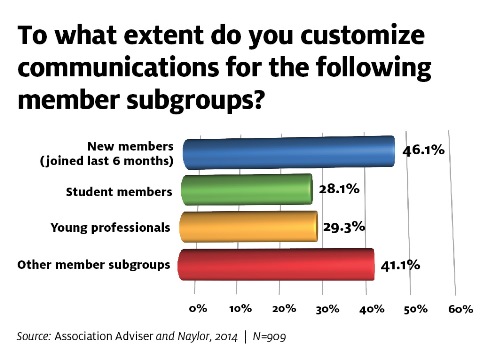Associations Still Trying to Get By With One-Size-Fits-All Messaging
Job growth and other economic indicators are improving every quarter, but have association membership levels followed suit? According to our recent unscientific poll of Association Adviser readers, most associations (83 percent) are within 10 percent of their pre-recession membership levels. Not bad, but many wonder if they’ll fully return to the flush days before the global financial crisis. In fact, one in six respondents (17 percent) told us “we’re never going back to those days.”
As Sharon Kneebone explains in today’s Corner Office profile, many companies are no longer paying their employees’ association dues. And with staffing levels still well below pre-2008 levels, many employees are simply too busy to “engage” with an association in the traditional sense, said Kneebone the membership director for the Institute of Food Technologists (IFT).
What’s more, most associations still aren’t communicating their member benefits very effectively and they’re not tailoring their messages to appeal to different member subgroups. As our annual association communication benchmarking study revealed, less than half (46.1 percent) of the 1,031 respondents said they produce customized communications for new members. Even fewer respondents said they’re sending customized communications to other subgroups, such as student members (28.1percent), young professionals (29.3 percent) and other member segments (41.4 percent).
Greg Melia, CAE, chief membership and volunteer relations officer at ASAE: The Center for Association Leadership, told us that the one-size-fits-all membership model is outdated. “Newer members might not be aware of all of the benefits that they are entitled to and may have been attracted to one specific benefit that they only had a temporary need for. Customized communications can ensurethat your members are aware of services to which they are entitled, which may compel them to stay with your association when it becomes time to renew their dues.”
As one respondent to our annual communication benchmarking report told us: “Everyone assumes the next-generation member is going to be completely tech savvy and mobile, but the old phone call technique still hits home with them.” Another respondent suggested spending the time to find out how each member subgroup wants to be communicated with. “Make sure you use personal contact and face-to-face when available. It always helps to put a face with an association. Looking like you care will never go out of style.”
Tamara Groom has more 2014 benchmarking research findings in her article Five Recommendations for a Winning Communications Strategy.


